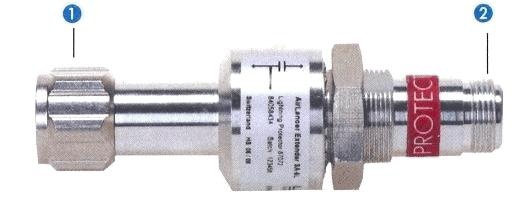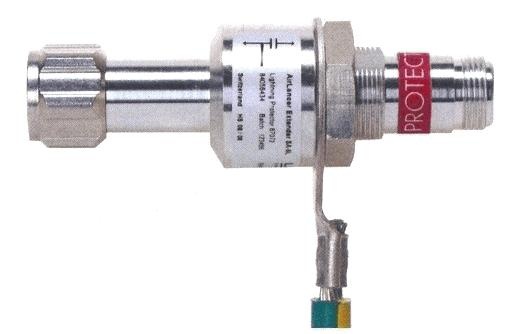Description:
This document describes the two connectors on an AirLancer Extender SA-5L and AirLancer Extender SA-LAN.
AirLancer Extender SA-5L:
An AirLancer Extender SA-5L is used to reduce over-voltages on the antenna cable.
The AirLancer Extender SA-5L has two connectors and is positioned between the access point and the antenna:

1) N-connector for connection to the antenna (unprotected section)
2) N-connector for connection to the access point (protected section)
Connecting to the access point
First, connect the end of the adapter cable to the N-connector of the AirLancer Extender SA-5L. Then connect the other end of the adapter cable to the access point's antenna output.
Connecting to the antenna
For the connection to the antenna, first connect one end of the antenna cable to the N-connector of the AirLancer Extender SA-5L. Then connect the other end of the antenna cable to the antenna's input.
Grounding of the AirLancer SA-5L
The mounting of the AirLancer Extender SA-5L must be sufficiently earthed so that any over-voltages can be conducted away to the building's earthing system.

To ground the AirLancer Extender SA-5L, a cable lug should be fixed with a nut to the protected side of the over-voltage adapter. Earthing can be implemented as follows depending on the application:
- For access points installed indoors, the potential load is equalized via the building's grounding line by PE cable (protective earth cable, 1.5 mm² Cu).
-
- For an access point mounted outdoors, its ground and the ground of the AirLancer Extender SA-5L are connected via the potential-equalization lead (16 mm² Cu) of the mast or of the antenna, e.g. via the antenna mounting clamps.
AirLancer Extender SA-LAN:
An AirLancer Extender SA-LAN can be used to reduce possible over-voltages on the Ethernet or PoE cable.
The AirLancer Extender SA-LAN has two connectors and is positioned between the access point and the LAN:

The SA-LAN is used to interconnect the protected section on the LAN side and the unprotected section on the access point side.
The SA-LAN is labeled so that you can tell which side is protected or unprotected. |
|